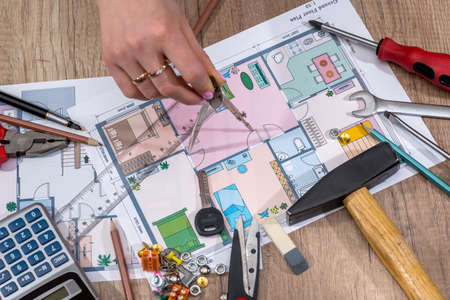The Role of an Interior Designer in the UK
When considering the value of hiring an interior designer across the UK, it’s essential to understand the multifaceted role these professionals play in transforming British homes. Interior designers offer more than just aesthetic improvements; they bring a creative vision that is thoughtfully tailored to both the property’s architecture and the homeowner’s unique lifestyle. Whether working with a classic Victorian terrace in London or a modern apartment in Manchester, designers blend their expertise with local sensibilities, ensuring each space feels authentic and practical for everyday living. Beyond selecting fabrics and colours, interior designers manage the entire process from concept to completion, overseeing budgets, sourcing quality materials, and liaising with trusted tradespeople. Their project management skills mean homeowners can avoid costly mistakes and save valuable time. Ultimately, an interior designer’s value in the UK is measured by their ability to interpret your aspirations, maximise your investment, and create a home that harmoniously reflects both your personality and the rich diversity of British property styles.
2. Breaking Down the Costs: What Are You Paying For?
When considering hiring an interior designer in the UK, transparency around costs is key to making a well-informed decision. Fee structures can vary not only by designer but also across different regions—from the bustling streets of London to the serene countryside of Yorkshire. Understanding these differences helps homeowners appreciate where their investment goes and what value a professional brings to their space.
Typical Interior Design Fee Structures
| Fee Structure | Description | Common Use in UK Regions |
|---|---|---|
| Fixed Fee | A set price for the entire project, agreed upon upfront. | Popular in Greater London and larger cities for full-home or large room renovations. |
| Hourly Rate | Billed per hour of work, ideal for smaller projects or consultations. | Frequently used in suburban and rural areas; flexible for bespoke services. |
| Percentage of Project Cost | A percentage (usually 10-20%) based on the total project spend. | Standard for high-end projects or when designers manage purchases and contractors. |
| Day Rate | A daily charge, often used for on-site supervision or styling days. | Common for staging homes in competitive markets like Edinburgh or Manchester. |
How Designers Calculate Their Charges
Designers typically begin with an initial consultation—sometimes complimentary, sometimes charged at a nominal rate—to assess your needs and the scale of your project. Following this, fees are calculated based on factors such as:
- The complexity of your space: Larger or period properties often require more detailed planning and sourcing.
- The level of service required: Full-service design, including project management and procurement, will cost more than a basic mood board or colour consultation.
- Your location: Rates are generally higher in London and the South East compared to the Midlands, North, or Scotland, reflecting both local demand and cost of living variations.
- The designer’s experience and reputation: Established names command premium fees but may bring unique access to trade discounts and exclusive suppliers.
What’s Commonly Included in UK Interior Design Packages?
| Service Element | Description / Typical Inclusion | Regional Nuance |
|---|---|---|
| Initial Consultation & Briefing | Discussion of needs, aspirations, and budget setting. | Often free outside London; may be charged in high-demand urban centres. |
| Concept Development & Mood Boards | The creative vision—colours, materials, layouts presented visually. | A core part of all packages nationwide; level of detail may vary regionally. |
| Sourcing & Procurement | Selecting furniture, finishes, lighting, and arranging orders/deliveries. | Larger cities offer broader supplier networks; rural areas may incur additional delivery fees. |
| Project Management | Liaising with tradespeople, scheduling works, quality checks. | This is often optional; more common in full-service packages in metropolitan areas. |
| Dressing & Styling | The finishing touches—artwork placement, accessories styling before handover. | A signature service for show homes or property sales especially in competitive Southern markets. |
The Bottom Line: Regional Differences Matter
No matter where you live in the UK, clarity on fee structures ensures you know precisely what you’re getting for your investment. While London-based designers may charge more due to higher overheads and market demand, regional specialists offer distinct local insights and tailored approaches. Understanding these nuances empowers you to make choices that align with both your aesthetic goals and your budget.

3. Cultural Influences on Design Value
The value of interior design in the UK is deeply entwined with the nation’s rich tapestry of heritage, contemporary trends, and unique local sensibilities. British homes are often viewed as reflections of personal taste, but they are also steeped in historical context—think Georgian proportions, Victorian detailing, or the rustic charm of a Cotswolds cottage. These enduring architectural narratives not only guide client expectations but also inform how designers approach each project, balancing respect for period features with modern functionality.
Honouring Heritage in Modern Spaces
Across the UK, there is a distinct appreciation for preserving original character. Whether restoring cornicing in a London townhouse or repurposing reclaimed materials in a converted barn, interior designers are valued for their ability to sensitively enhance historic elements. This respect for heritage directly influences perceived value: clients expect designers to weave traditional craftsmanship and local materials into schemes that feel both timeless and relevant.
Embracing Contemporary Trends with British Flair
While tradition holds sway, contemporary design movements—from minimalist Scandinavian touches to bold mid-century statements—are increasingly popular in British homes. However, these trends are rarely adopted wholesale. Instead, British sensibility favours an eclectic mix: layering old with new, combining statement wallpapers with classic upholstery, or integrating smart home technology without sacrificing warmth. Designers are prized for their skill in curating such harmonious juxtapositions—making their services all the more valuable to discerning clients.
Local Sensibilities and Regional Identity
The UK’s diverse regions add another layer to the value equation. Coastal Cornwall calls for light-filled interiors echoing its seascapes, while Edinburgh’s grand flats might require a nod to Scottish textiles and heritage hues. Understanding these subtle distinctions enables designers to tailor their services—and pricing—to specific markets. Ultimately, it’s this sensitivity to place, tradition, and evolving lifestyles that underpins the true worth of interior design across the UK.
4. Added Value: Beyond Aesthetics
When considering the true worth of an interior designer in the UK, it’s vital to look past the immediate visual transformation. The value they add extends far beyond aesthetic appeal, offering a range of tangible and intangible benefits that impact your daily life and long-term investment.
Unlocking Hidden Potential
An experienced interior designer brings a trained eye for optimising British homes, which are often defined by compact footprints and unique architectural quirks. They expertly reimagine awkward nooks or underused areas—turning a cramped Victorian terrace or a modest London flat into a functional, inviting sanctuary. By maximising every square inch, they ensure no space is wasted.
Boosting Property Value
One of the less obvious but highly valuable outcomes of professional design is its positive effect on your property’s market worth. Thoughtful layouts, clever storage solutions, and tailored finishes can significantly increase buyer appeal and sale price. This isn’t just about staging; it’s about lasting upgrades that stand out in the competitive UK property market.
| Benefit | Description | Impact on Homeowner |
|---|---|---|
| Optimised Space | Clever planning to maximise utility in smaller UK homes | More comfort and usability in everyday living |
| Increased Value | Bespoke design elevates property’s financial worth | Potential for higher resale or rental income |
| Stress Reduction | Project management & problem-solving handled by experts | Smoother process with fewer headaches for owners |
| Tailored Solutions | Personalised designs reflect lifestyle & needs | A home that truly fits you and your family’s way of life |
Reducing Stress: From Concept to Completion
The journey from vision to reality can be daunting—especially with the demands of British planning permissions, sourcing quality local tradespeople, or managing deliveries amid unpredictable weather. Designers take on these logistical challenges, acting as your advocate and project manager throughout. This reduces stress, saves time, and ensures the result aligns with both your tastes and practical requirements.
Local Insight Matters
UK-based designers also bring invaluable local knowledge—whether it’s understanding regional style preferences, navigating historic building regulations, or recommending trusted suppliers from Cornwall to Edinburgh. This expertise not only speeds up the process but helps avoid costly missteps.
The Long-Term Perspective
The most rewarding aspect? The value added by an interior designer endures long after installation. You gain a thoughtfully designed space that enhances daily wellbeing while future-proofing your investment—making professional design a wise choice across the UK’s diverse housing landscape.
5. How to Maximise Your Investment
Engaging an interior designer in the UK is not just about aesthetics—it’s a strategic investment. To ensure every pound delivers value, British clients should adopt a collaborative, informed approach throughout the design journey. Here are expert tips to help you work effectively with your designer and achieve your dream space without compromising on quality or budget.
Establish Clear Goals and Priorities
Begin by articulating your vision, lifestyle needs, and must-haves. A comprehensive brief helps your designer focus resources where they matter most—be it a period property in Bath or a contemporary flat in London. Setting priorities early ensures that both functional requirements and personal style are seamlessly woven into the final design.
Maintain Open Communication
Regular dialogue is key. Schedule check-ins and provide timely feedback to keep the project on track. Don’t hesitate to ask questions about material choices or cost-saving alternatives; experienced UK designers are adept at sourcing local products that deliver both value and authenticity.
Trust Your Designer’s Expertise
British interior designers bring a wealth of experience navigating building regulations, supplier networks, and heritage considerations unique to the UK. Trust their guidance when balancing budget constraints with long-term durability and style—often, investing slightly more upfront yields greater longevity and satisfaction.
Embrace Flexibility
Inevitable surprises can arise, particularly with older homes or listed buildings. Being open to creative solutions allows your designer to adapt quickly and find ways to preserve character while meeting modern standards—a hallmark of successful British renovations.
Request Detailed Cost Breakdowns
A reputable designer will provide transparent quotations for labour, materials, furnishings, and fees. Understanding exactly where your money goes enables you to make informed decisions—perhaps allocating more towards statement lighting or bespoke joinery that enhances everyday living.
Plan for the Future
Consider how your needs may evolve. Designers can future-proof layouts for growing families or changing mobility, ensuring lasting value from your investment. Ultimately, working closely with your chosen professional guarantees a tailored result that feels truly British—thoughtful, refined, and built to endure.
6. Regional Differences: London vs The Rest of the UK
When evaluating the value offered by interior designers across the UK, it’s crucial to recognise the distinct regional differences that shape expectations, pricing, and design sensibilities. Nowhere is this contrast more pronounced than between London and other parts of the country.
London: The Capital Premium
London remains at the epicentre of design innovation and luxury living, but this comes with a cost. Interior designer fees in the capital are notably higher, reflecting both the high cost of living and elevated client expectations. Projects in London often involve tight timelines, complex planning permissions, and a focus on bespoke, high-end finishes. Clients here typically seek cutting-edge trends and signature aesthetics, expecting seamless project management and access to exclusive suppliers. The value proposition is therefore measured not just in transformation but also in prestige and convenience.
Other Cities: Balancing Budget with Style
Cities like Manchester, Birmingham, Edinburgh, and Bristol offer a more balanced approach. While their design scenes are vibrant and increasingly sophisticated, costs are generally lower than London’s without sacrificing creative flair. Here, clients prioritise smart spatial solutions and functional elegance over sheer opulence. Interior designers in these areas often deliver remarkable value by marrying quality with practicality—transforming spaces within more modest budgets while still capturing local flavour and contemporary trends.
Rural & Coastal Communities: Contextual Creativity
Beyond urban centres, rural villages and coastal towns present unique opportunities for interior designers. Budgets may be tighter, but there is a strong emphasis on personal connection, authenticity, and sustainability. Local materials, craftspeople, and heritage often take centre stage in these projects. Designers adapt their approach to highlight natural light, views, and original features—creating inviting homes that celebrate their setting. Value here is defined by thoughtful adaptation rather than grand gestures; success lies in delivering comfort, character, and longevity within realistic financial boundaries.
The Takeaway: Tailored Value Across Regions
Ultimately, what you get for your money varies greatly depending on where you live in the UK. Whether seeking metropolitan chic or countryside charm, understanding regional nuances helps set realistic expectations—and ensures your investment delivers true value tailored to your location’s unique spirit.

